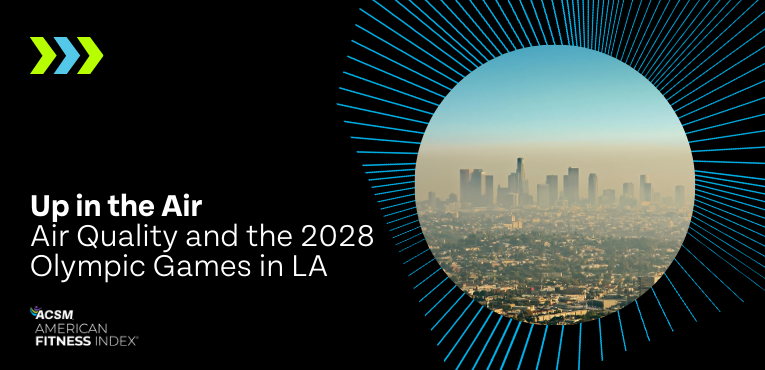Joe Sherlock, ACSM Copywriter |
Sept.
17, 2024
 With the 2028 summer Olympic and Paralympic Games heading to Los Angeles, there’s a big question hovering over everyone’s head: what about all the smog?
With the 2028 summer Olympic and Paralympic Games heading to Los Angeles, there’s a big question hovering over everyone’s head: what about all the smog?
According to the American Fitness Index, a partnership between the American College of Sports Medicine® (ACSM) and the Elevance Health Foundation that has been tracking health behaviors and outcomes in America’s 100 largest cities since 2008, Los Angeles only experiences “good air quality” 11% of the time. By comparison, the average for all 100 cities included in the rankings was 63.9%, and the highest belonged to Honolulu, for understandable reasons, at 99.5%.
(For reference, the Fitness Index made use of the Environmental Protection Agency’s [EPA’s] Air Quality Index, or “AQI,” for its rankings.)
An old enemy
It's no secret that LA’s air quality leaves something to be desired. Beyond its Fitness Index ranking, it remains, according to the South Coast Air Quality Management District (AQMD), the literal worst in the nation. Nor is the problem at all new. The AQMD shares, on the same page, that “Industrial smoke and fumes were so thick during one day in 1903 that residents mistook it for an eclipse of the sun.” So there’s that.
Bad outcomes
According to Liz Joy, M.D., MPH, FACSM, chief medical officer at Lore Health LLC and a past president of ACSM, “There is incontrovertible evidence linking poor air quality to adverse health outcomes.” Poor air quality is worse for people with preexisting conditions like stroke, asthma, heart disease and chronic obstructive pulmonary disease (COPD), but it’s no walk in the park for the average person either; certain types have even been linked to dementia.
Concerns for athletes
Here’s the rub when it comes to the Olympic and Paralympic Games. When you exercise, you exchange way more air than when you’re sitting still. Athletes working at a high level will be breathing much more bad air than the spectators in attendance.
For instance, according to Joy, “An athlete running at 70 percent of their maximal oxygen uptake for the length of a marathon inhales the same volume of air as a sedentary person does in two days.”
What to do
The question, then, is how can LA mitigate the air quality issue? If the city has been experiencing poor air quality for, to put it in perspective, at least four to six generations, it seems unlikely that anyone is going to clear the air in the next four years. Perhaps more of the Games’ events could be held indoors rather than in the open. Timing also seems to be a factor; with much of LA’s air pollution coming from vehicles, scheduling events outside of rush hour might conceivably have an effect. And on a personal level, anyone can visit AirNow.gov (a multiagency government collaboration) to look at air quality conditions in their local area at any given time. There’s even an app.
Some parting thoughts
Overall, though, the issue is more one of visibility. (No, not literal visibility, though that’s important too.) The convergence of America’s worst air quality with the world’s best athletes provides sports medicine and exercise science practitioners, researchers and professionals with the opportunity to discuss and even move the sociopolitical needle on air quality.